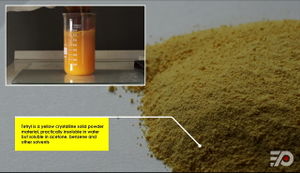Tetryl
 Tetryl sample
| |
| Names | |
|---|---|
| IUPAC name
2,4,6-Trinitrophenylmethylnitramine
| |
| Preferred IUPAC name
N-Methyl-N-(2,4,6-trinitrophenyl)nitramide | |
| Other names
N-Methyl-N,2,4,6-tetranitroaniline
N-Methyl-N,2,4,6-tetranitrophenyl-1-amine N-Methyl-N-picrylnitramine N-Picryl-N-methylnitramine Nitramine Tetralite Tetril | |
| Properties | |
| C7H5N5O8 | |
| Molar mass | 287.14 g/mol |
| Appearance | Yellow crystalline solid |
| Odor | Odorless |
| Density | 1.73 g/cm3 |
| Melting point | 129.5 °C (265.1 °F; 402.6 K) |
| Boiling point | 187 °C (369 °F; 460 K) (decomposition) |
| Insoluble | |
| Solubility | Soluble in glacial acetic acid, acetone, benzene, diethyl ether, |
| Vapor pressure | <1 mmHg (20 °C) |
| Thermochemistry | |
| Hazards | |
| Safety data sheet | CPCB |
| Except where otherwise noted, data are given for materials in their standard state (at 25 °C [77 °F], 100 kPa). | |
| Infobox references | |
 |
This article is a stub. Please help Sciencemadness Wiki by expanding it, adding pictures, and improving existing text.
|
Tetryl (IUPAC: 2,4,6-trinitrophenylmethylnitramine) is an explosive compound used to make detonators and explosive booster charges. It has the chemical formula C7H5N5O8.
Contents
Properties
Chemical
Tetryl burns when ignited, giving off black smoke.
Physical
Tetryl is a yellow solid, insoluble in water.
Explosive
Tetryl explodes when subjected to strong heating. Its detonation velocity is 7,570 m/s. It has a R.E. factor of 1.25.
Availability
Tetryl is sold as detonators. Purchase requires an explosive permit.
Preparation
Tetryl can be made by adding dimethylaniline to a mixture of conc. nitric acid and sulfuric acid under controlled conditions.
Projects
- Make detonators
Handling
Safety
Tetryl is toxic and explosive. Should be handled with care and proper protection.
Storage
Should be stored for short periods of time, in spark-free containers.
Disposal
Can be destroyed via controlled incineration.
Another method involves the slow and controlled addition in Fenton's reagent.